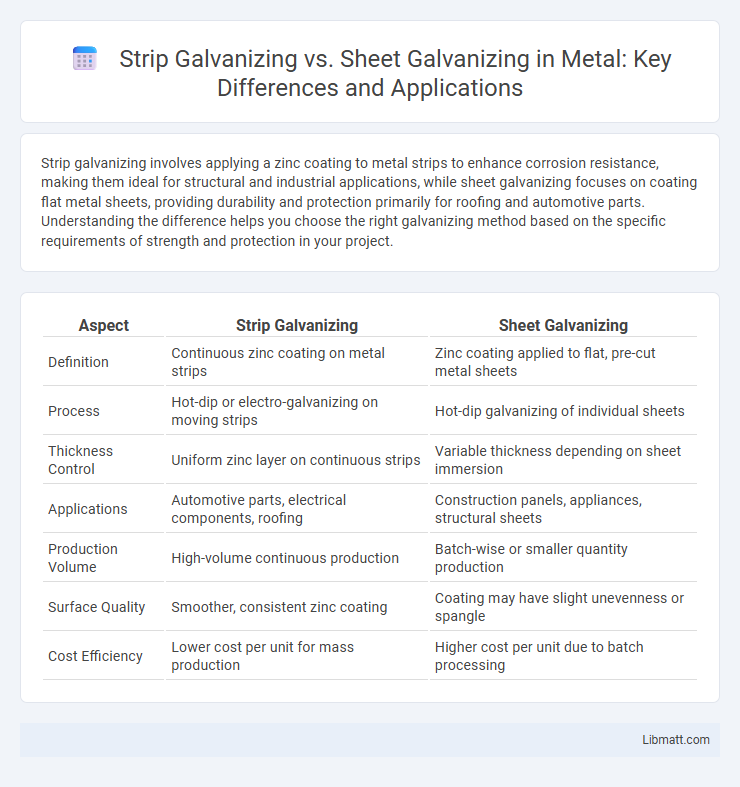Strip galvanizing involves applying a zinc coating to metal strips to enhance corrosion resistance, making them ideal for structural and industrial applications, while sheet galvanizing focuses on coating flat metal sheets, providing durability and protection primarily for roofing and automotive parts. Understanding the difference helps you choose the right galvanizing method based on the specific requirements of strength and protection in your project.
Table of Comparison
| Aspect | Strip Galvanizing | Sheet Galvanizing |
|---|---|---|
| Definition | Continuous zinc coating on metal strips | Zinc coating applied to flat, pre-cut metal sheets |
| Process | Hot-dip or electro-galvanizing on moving strips | Hot-dip galvanizing of individual sheets |
| Thickness Control | Uniform zinc layer on continuous strips | Variable thickness depending on sheet immersion |
| Applications | Automotive parts, electrical components, roofing | Construction panels, appliances, structural sheets |
| Production Volume | High-volume continuous production | Batch-wise or smaller quantity production |
| Surface Quality | Smoother, consistent zinc coating | Coating may have slight unevenness or spangle |
| Cost Efficiency | Lower cost per unit for mass production | Higher cost per unit due to batch processing |
Introduction to Galvanizing Methods
Strip galvanizing involves coating steel strips with a layer of zinc through a hot-dip process, providing corrosion resistance for applications like automotive and construction materials. Sheet galvanizing typically refers to the continuous hot-dip coating of steel sheets, enhancing durability and rust protection for roofing, siding, and appliance manufacturing. Understanding the distinction helps you select the appropriate galvanizing method based on the material form and intended use, ensuring optimal performance and longevity.
Understanding Strip Galvanizing
Strip galvanizing involves coating steel strips with a uniform layer of zinc through continuous hot-dip processes, enhancing corrosion resistance and surface finish for applications like automotive components and electrical equipment. This method offers precise control over coating thickness and quality, crucial for maintaining material flexibility and durability during subsequent fabrication. Compared to sheet galvanizing, strip galvanizing emphasizes consistency in thin, narrow steel strips, optimizing performance in high-speed production environments.
Overview of Sheet Galvanizing
Sheet galvanizing involves coating flat steel sheets with a protective layer of zinc by passing them through a molten zinc bath, enhancing corrosion resistance and durability. This process ensures uniform zinc coverage, making it ideal for architectural applications, automotive panels, and appliances. The zinc layer in sheet galvanizing provides excellent adhesion and long-lasting protection against environmental elements.
Key Process Differences
Strip galvanizing involves continuously coating metal strips by passing them through a molten zinc bath, ensuring uniform coverage on both sides, while sheet galvanizing typically applies zinc coatings to flat metal sheets using batch or continuous methods. Strip galvanizing emphasizes high-speed production for thin coils used in automotive or appliance industries, whereas sheet galvanizing handles larger, individual sheets often for construction applications. Your choice depends on production volume, metal form, and desired coating consistency.
Surface Finish and Coating Quality
Strip galvanizing offers a smoother surface finish due to continuous processing, resulting in uniform zinc coating thickness and superior corrosion resistance. Sheet galvanizing often exhibits slight surface irregularities because of batch processing, which can affect coating consistency and durability. Your choice depends on the desired aesthetic quality and performance requirements of the final product.
Applications and Industry Uses
Strip galvanizing is commonly used in automotive and construction industries for coating steel strips and coils, offering excellent corrosion resistance in structural components and metal roofing. Sheet galvanizing finds its primary applications in household appliances, HVAC systems, and metal furniture manufacturing due to its uniform zinc coating and high surface quality. Your choice between strip and sheet galvanizing depends on the specific industry requirements for durability, surface finish, and production scale.
Durability and Corrosion Resistance
Strip galvanizing offers superior durability and corrosion resistance due to its thicker zinc coating, which provides enhanced protection against harsh environmental conditions. Sheet galvanizing typically has a thinner zinc layer, making it more suitable for applications where lightweight and moderate corrosion protection are sufficient. Choosing strip galvanizing for Your projects ensures longer-lasting metal components that withstand corrosion better over time.
Cost Factors and Efficiency
Strip galvanizing generally incurs lower material costs due to the continuous processing of steel strips, allowing for high-volume production and faster turnaround times. Sheet galvanizing, while offering better control over coating uniformity and thickness, often results in higher labor and energy expenses, reducing overall cost efficiency. Evaluating the balance between production speed and quality requirements is crucial when selecting between strip and sheet galvanizing methods.
Environmental Impact and Sustainability
Strip galvanizing typically offers a lower environmental impact than sheet galvanizing due to its efficient use of zinc and reduced energy consumption during the continuous process. The continuous coating method in strip galvanizing minimizes waste and emissions, promoting sustainability by extending the lifespan of steel products with less frequent need for re-coating or replacement. Sheet galvanizing often involves batch processing, which can consume more energy and produce higher levels of galvanizing waste, making strip galvanizing a more eco-friendly choice for sustainable metal protection.
Choosing Between Strip and Sheet Galvanizing
Choosing between strip galvanizing and sheet galvanizing depends on the specific application requirements and material specifications. Strip galvanizing is ideal for narrow steel strips that require high-quality, continuous zinc coatings, enhancing corrosion resistance and surface finish. Sheet galvanizing suits larger steel sheets demanding uniform protective layers, making it optimal for construction, automotive, and appliance manufacturing industries.
Strip Galvanizing vs Sheet Galvanizing Infographic

 libmatt.com
libmatt.com